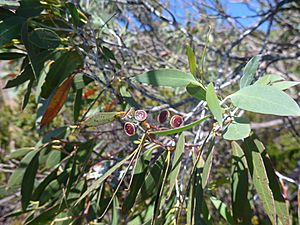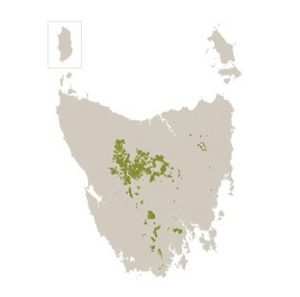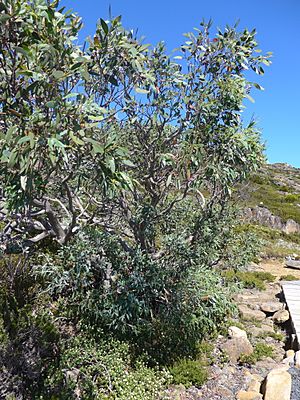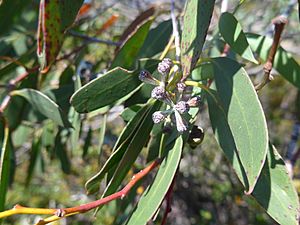Tasmanian snow gum facts for kids
Quick facts for kids Tasmanian snow gum |
|
|---|---|
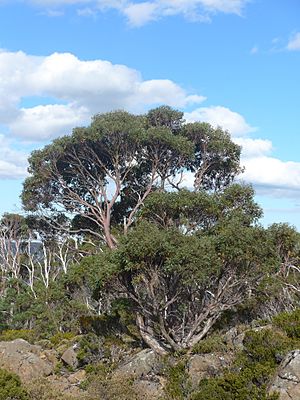 |
|
| Eucalyptus coccifera tree line in Mt. Field National Park. | |
| Scientific classification | |
| Genus: |
Eucalyptus
|
| Species: |
coccifera
|
The Eucalyptus coccifera, also known as the Tasmanian snow gum, is a special tree found only in Tasmania. It's a small to medium-sized tree with smooth, grey, and cream-colored bark. Its leaves are shaped like ellipses or lances. The tree produces groups of three to nine flower buds, which usually open into white flowers. Later, it grows fruit that looks like a cone, a half-sphere, or a cup.
Contents
What Does the Tasmanian Snow Gum Look Like?
The Tasmanian snow gum, Eucalyptus coccifera, usually grows up to 15 meters (about 49 feet) tall. Sometimes, it can be a smaller, bushy plant called a mallee, growing to about 5 meters (16 feet). Its bark is smooth and light grey to white, often with streaks of tan.
Leaves and Flowers
Young plants have blue-green leaves that are shaped like ellipses or hearts. These leaves are about 15-45 mm long and 7-23 mm wide. As the tree gets older, its leaves change. Adult leaves are shiny green to bluish on both sides. They are 50-100 mm long and 10-20 mm wide.
The flowers grow in groups of three, seven, or nine. They are found where the leaves meet the stem. Each flower bud is oval-shaped and has a waxy, bluish-white coating. They are 5-8 mm long and 4-7 mm wide. The tree blooms between December and February. Its flowers are usually white, but sometimes they can be pink.
Fruit of the Snow Gum
After the flowers, the tree produces a hard, woody fruit. This fruit is called a capsule. It can be shaped like a cone, a half-sphere, or a cup. These capsules are 6-12 mm long and 8-13 mm wide.
How Was the Tasmanian Snow Gum Named?
The Tasmanian snow gum was first officially described in 1847 by a scientist named Joseph Dalton Hooker. He published his description in a journal called London Journal of Botany.
Meaning of the Name
The scientific name coccifera comes from two old words. "Coccus" is a New Latin word from ancient Greek, meaning "seed of tree fruit." "Ferre" is a Latin word meaning "to carry." This name refers to the leaves sometimes having a type of insect called a Coccus on them.
The Tasmanian snow gum belongs to a group of eucalyptus trees called the "peppermint group." It is found only in central and southern Tasmania. It usually grows in high, sub-alpine areas, above 800 meters (about 2,600 feet) in height.
Where Does the Tasmanian Snow Gum Grow?
The Tasmanian snow gum is found only in Tasmania. It is the main type of tree in many exposed, rocky areas in the south and Central Plateau of Tasmania. These areas have a type of rock called dolerite. This rock helps the snow gum grow well.
Life Cycle of the Tasmanian Snow Gum
Eucalyptus flower buds usually take about a year to fully grow. For the Tasmanian snow gum and other trees that grow in high places, it takes even longer. Insects and birds help to pollinate the flowers. Fertilization can happen up to 20 days after pollination. The Tasmanian snow gum typically flowers from November to February.
Seeds and Regeneration
After fertilization, a hard, woody capsule develops. The seeds are released from this capsule when it dries out. This drying can be caused by very hot, dry weather or by fire. The wind helps to spread the seeds, but most seeds fall close to the parent tree. The Tasmanian snow gum can also regrow from special underground parts called lignotubers after a fire.
How Altitude Affects Growth
The Tasmanian snow gum mostly grows between 800 meters (2,600 feet) and 1,300 meters (4,265 feet) above sea level. At higher altitudes, around 1,300 meters, the trees are often smaller, blending into the alpine shrubs. They usually grow less than 10 meters (33 feet) tall there. Studies show that the higher the altitude, the slower the tree's stem grows.
At lower altitudes, the Tasmanian snow gum can grow much taller, sometimes up to 40 meters (130 feet). However, it's more common to see them around 20 meters (66 feet) tall, especially in places like the Central Plateau and Mt. Field National Park.
Changes in Leaves and Buds
As the altitude increases, the leaves and buds of the Tasmanian snow gum become more waxy and bluish-white. This waxy coating helps the tree resist frost better at higher altitudes. Also, the young leaves tend to stay on the tree longer in high-altitude areas.
Environment of the Tasmanian Snow Gum
The areas where the Tasmanian snow gum grows, like Mt. Field and Mt. Wellington, have a type of rock called Jurassic dolerite. This rock helps the soil drain well, which the snow gum prefers. While these rocks can provide nutrients, they break down slowly, so the soil isn't super rich.
Rainfall and Water
In Tasmania, rainfall generally increases with altitude. So, the snow gum populations in exposed areas get a lot of rain. For example, Mt. Wellington gets over 1,300 mm (51 inches) of rain each year, and Mt. Field gets around 2,500 mm (98 inches).
Even with a lot of rain, water can sometimes be a problem for the snow gum. This is because Tasmanian rainfall can be unpredictable. Also, the rocky soil drains water very quickly. While good drainage is usually helpful, too much water (waterlogging) can slow down the snow gum's growth.
Dealing with Temperatures
The Tasmanian snow gum is very good at handling both frost and drought. This allows it to live in very exposed, high-altitude places. It has to deal with hot, dry summers and very cold, frosty winters.
For example, at 1,250 meters (4,100 feet) on Mt. Wellington, the average highest temperature in July is 1.9°C (35.4°F), and the lowest is -2.0°C (28.4°F). In January, the average highest is 12.8°C (55.0°F), and the lowest is 4.4°C (39.9°F). Mt. Wellington is closer to the ocean, so its temperatures are a bit milder, especially in summer.
Frost, Snow, and Mist
Even though the snow gum is tough against frost, very extreme frost events can limit where these trees can grow. Similarly, how long snow stays on the ground affects which plants can survive in alpine areas. Since snow in Tasmania doesn't stay all year, woody plants like the snow gum can live at higher altitudes.
Mist can also affect the snow gum. Mist is more common at higher altitudes, especially in colder months. It can make it harder for plants to photosynthesize (make their own food) because it reduces sunlight and causes water to build up on the leaves.
Other Plants Growing with the Snow Gum
The areas where the Tasmanian snow gum grows often have many woody shrubs. These include plants from the Ericaceae family (like Richea, Epacris, and Cyathodes) and the Proteaceae family (like Orites acicularis and Orites revoluta). Small conifers like Diselma archerii and Microachrys tetragona are also common.
At lower altitudes, other eucalyptus species start to appear alongside the snow gum. These include Eucalyptus subcrenulata and Eucalyptus urnigera in Mt. Field, and Eucalyptus delegatensis in both Mt. Field and Mt. Wellington.
| Altitude | Eucalypt species present | Vegetation type |
|---|---|---|
| 250 meters (820 feet) | Eucalyptus obliqua,
Eucalyptus regnans (most common) |
Wet sclerophyll forest |
| 700 meters (2,300 feet) | Eucalyptus delegatensis | Mixed forest |
| 1,000 meters (3,280 feet) | Eucalyptus coccifera (most common),
Eucalyptus subcrenulata (most common), Eucalyptus urnigera |
Subalpine woodland |
| 1,200 meters (3,940 feet) | Eucalyptus coccifera | Subalpine sclerophyll heath |
Table 1. This table shows how the types of eucalyptus trees change as you go higher up in Mt. Field National Park.
See also
 In Spanish: Eucalyptus coccifera para niños
In Spanish: Eucalyptus coccifera para niños


